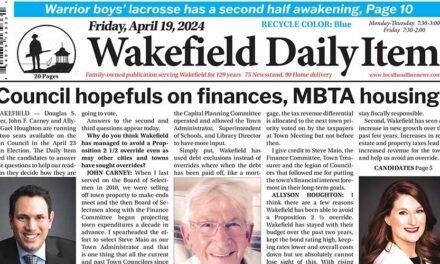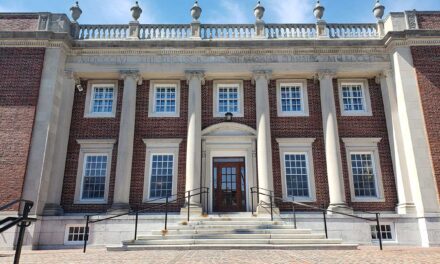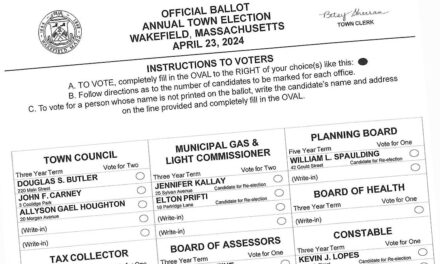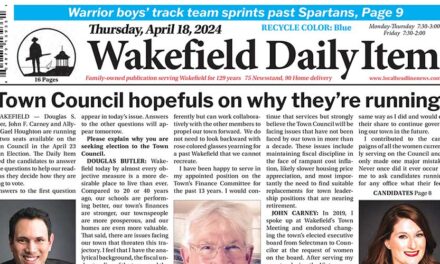Published in the February 15, 2018 edition.
By MARK SARDELLA
WAKEFIELD – The Massachusetts Energy Facilities Siting Board (EFSB) yesterday issued its Tentative Decision approving the 345kV Woburn to Wakefield underground transmission line project proposed jointly by National Grid and Eversource.
The EFSB decision includes approval of the 8.5-mile “preferred route,” which will run from the Eversource Substation in Woburn, through Winchester and Stoneham before entering Wakefield. In Wakefield, the approved 3.5-mile route would come down Albion Street and Broadway, cross North Avenue and then follow the abandoned railroad bed for approximately one mile, running across Bennett Street, Richardson Street and Water Street. The line would continue along the railroad bed before turning down Salem Street to Montrose Avenue and up the access road to the National Grid Substation.
The EFSB decision noted that in 2015, ISO-NE (the nonprofit agency charged with ensuring energy reliability throughout New England) identified numerous deficiencies and reliability needs within the Greater Boston Area.
“For these reasons, the Siting Board finds that additional energy resources are needed to maintain a reliable supply of electricity to the Greater Boston Area,” the decision states.
The EFSB found the companies properly notified the public and specifically abutters in all four communities, including notice published in newspapers as well as notice, with a one-page summary, by first class mail to the property owners abutting the Primary Route and the Noticed Alternative Route and abutters to the abutters within 300 feet of the route.
Some in Wakefield have argued in favor of a route that would go down New Salem Street, which has fewer homes, as an alternative to using a portion of Salem Street. But the EFSB noted the potentially greater environmental impact of a New Salem Street route, which abuts a wetland. The EFSB ruled that the original preferred Salem Street route can go forward.
Another bone of contention locally has been a fear of negative health effects for electromagnetic fields (EMF). Some have called for using a type of cable that cancels some of those magnetic fields. But the EFSB has declined to order that National Grid and Eversource use that type of cable.
The EFSB noted that over the years, some epidemiology studies have yielded statistical associations between power-frequency magnetic-fields and diseases such as childhood leukemia. But the decision also observes that in 2007, the World Health Organization (WHO) concluded that “the evidence for a causal relationship is limited, therefore exposure limits based upon epidemiological evidence are not recommended, but some precautionary measures are warranted.” Due to public concern over magnetic fields, the EFSB decision encouraged the use of low-cost measures that would minimize magnetic fields along transmission route.
Those measures do not include the use of high-pressure, fluid-filled (HPFF) cable, which the towns of Stoneham and Winchester have requested, due to their magnetic field-canceling properties. But the EFSB found that the HVED cable system proposed by the companies “is superior to an HPFF-PTC system for the project based on capacity, cost, potential environmental impacts, and reliability.”
The EFSB decision notes that the companies have pledged that that access to schools and activities on school grounds would be maintained throughout project construction. Specifically in Wakefield, the companies have “proposed to limit construction work in front of the Doyle School, located off of Albion Street in Wakefield, to summer months.”
Because the in-street construction is in close proximity to many residential areas, the EFSB decision directs the companies to limit construction of the transmission line to Monday through Friday from 7 a.m. to 5 p.m. in residential areas. The decision also directs the companies to use portable noise barriers in locations where there are residences, commercial businesses, and other sensitive receptors within 100 feet of trenchless crossing entry and exit pits.
Another issue that has been raised in Wakefield is the potential removal of trees. The companies have said that the only major impact on vegetation would be along the railroad right of way in Wakefield. The decision notes that the abandoned railroad bed has not been in active use for many years and, due to lack of maintenance, the area is overgrown with small saplings, trees and brush along the majority of its length, some portion of which would be removed as part of the project.
The companies have estimated that they would need to remove a total of 550 trees to facilitate construction, noting that roughly half of these trees are considered invasive or undesirable species. The EFSB decision notes that the companies have “committed to retain mature trees along the edges of the Wakefield railroad right of way to the extent possible.”
The EFSB also directs the companies to work with the town of Wakefield and the Wakefield Conservation Commission and offer, on a case by case basis, appropriate off-site screening for residences affected by tree-clearing along the Wakefield railroad right of way.
Regarding environmental impacts, the EFSB decision finds that the project constructed along the Primary Route would achieve an appropriate balance among conflicting environmental concerns as well as among environmental impacts, reliability, and cost.
The EFSB decision concludes with a lengthy list of conditions related to construction, noise and handling of contaminated soils as well as requirements for public outreach and notification during construction of the project.
According to Town Counsel Thomas Mullen, the EFSB’s “tentative decision” means that all parties have a chance to file written comments on the decision until Feb. 22, 2018. The Siting Board will also conduct a meeting to review the Tentative Decision on Tuesday, Feb. 27, 2018, in Hearing Room A, One South Station, Boston, MA, beginning at 1 p.m. Parties and Limited Participants will be given an opportunity to address the Siting Board about the Tentative Decision at the meeting. The EBSB may or may not incorporate any feedback into its Final Decision.
After that, Mullen said, the only recourse for anyone opposed to the project is limited and through the courts. It would have to be shown in court that the EFSB made a serious error, acted arbitrarily or capriciously or that the decision had no basis in the record.
“It’s a pretty difficult thing to do,” Mullen said.




